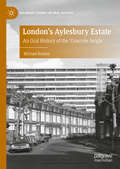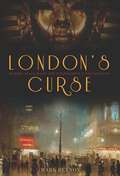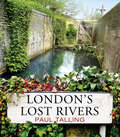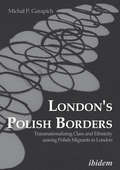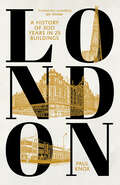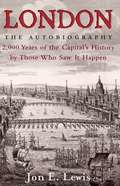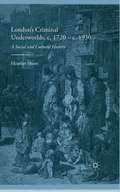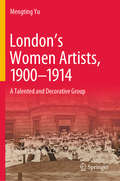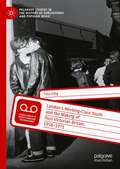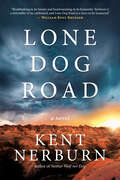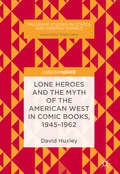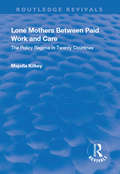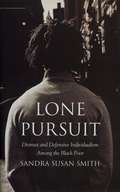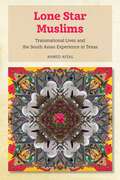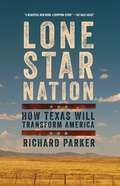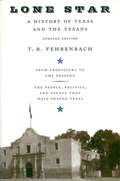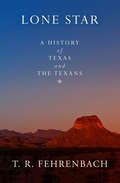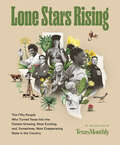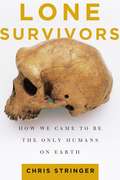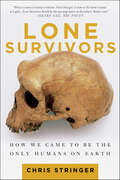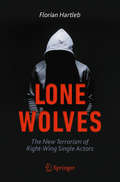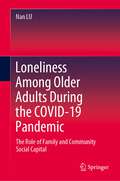- Table View
- List View
London's Aylesbury Estate: An Oral History of the 'Concrete Jungle' (Palgrave Studies in Oral History)
by Michael RomynThis book looks beyond the Aylesbury’s public face by examining its rise and fall from the perspective of those who knew it, based largely on the oral testimony and memoir of residents and former residents, youth and community workers, borough Councillors, officials, police officers and architects. What emerges is not a simple story of definitive failures, but one of texture and complexity, struggle and accord, family and friends, and of rapidly changing circumstances. The study spans the years 1967 to 2010 – from the estate’s ambitious inception until the first of its blocks were pulled down. It is a period rarely dealt with by historians of council housing, who have typically confined themselves to the years before or after the 1979 watershed. As such, it demonstrates how shifts in housing policy, and broader political, economic and social developments, came to bear on a working-class community – for good and, more especially, for ill.
London's Curse: Murder, Black Magic and Tutankhamun in the 1920s West End
by Mark BeynonThroughout the 1920s and 1930s, London was gripped by the supposed curse of Tutankhamun, whose tomb in the Luxor sands was uncovered in February 1923 by the British archaeologist Howard Carter. The site was plundered, and over the next few years more than twenty of those involved in the exhumation or in handling the contents of the tomb perished in strange and often terrifying circumstances, prompting the myth of the 'Curse of Tutankhamun'. Nowhere - particularly London's West End - appeared to be safe for those who had provoked the ire of the Egyptian death gods. A blend of meticulous research and educated conjecture, historian and screenwriter Mark Beynon turns armchair detective as he uncovers a wealth of hitherto unpublished material that lays bare the truth behind these fatalities. Could 'London's Curse' be attributed to the work of a macabre mastermind? It soon becomes apparent that these deaths were not only linked by the ominous presence of Tutankhamun himself, but also by a murderer hell-bent on retribution and dubbed by the press as 'The Wickedest Man in the World'.
London's Lost Rivers: a beautifully illustrated guide to London's secret rivers
by Paul TallingPacked with surprising and fascinating information, London's Lost Rivers uncovers a very different side to London - showing how waterways shaped our principal city and exploring the legacy they leave today. With individual maps to show the course of each river and over 100 colour photographs, it's essential browsing for any Londoner and the perfect gift for anyone who loves exploring the past...'An amazing book' -- BBC Radio London'Talling's highly visual, fact-packed, waffle-free account is the freshest take we've yet seen. A must-buy for anyone who enjoys the "hidden" side of London -- Londonist'A fascinating and stylish guide to exploring the capital's forgotten brooks, waterways, canals and ditches ... it's a terrific book' - Walk'Pocket-sized, beautifully designed, illustrated and informative - in short a joy to read, handle and use' -- ***** Reader review'Delightful, informative and beautifully produced' -- ***** Reader review'A small gem. A really great book. I can't put it down' -- ***** Reader review'Fascinating from start to finish' -- ***** Reader review************************************************************************************************From the sources of the Fleet in Hampstead's ponds to the mouth of the Effra in Vauxhall, via the meander of the Westbourne through 'Knight's Bridge' and the Tyburn's curve along Marylebone Lane, London's Lost Rivers unearths the hidden waterways that flow beneath the streets of the capital. Paul Talling investigates how these rivers shaped the city - forming borough boundaries and transport networks, fashionable spas and stagnant slums - and how they all eventually gave way to railways, roads and sewers. Armed with his camera, he traces their routes and reveals their often overlooked remains: riverside pubs on the Old Kent Road, healing wells in King's Cross, 'stink pipes' in Hammersmith and gurgling gutters on streets across the city. Packed with maps and over 100 colour photographs, London's Lost Rivers uncovers the watery history of the city's most famous sights, bringing to life the very different London that lies beneath our feet.
London's Polish Borders: Transnationalizing Class and Ethnicity among Polish Migrants in London
by Michal P. GarapichThe figure of the Polish plumber or builder has long been a well-established icon of the British national imagination, uncovering the UK's collective unease with immigration from Central and Eastern Europe. But despite the powerful impact the UK's second largest language group has had on their host country's culture and politics, very little is known about its members.This painstakingly researched book offers a broad perspective on Polish migrants in the UK, taking into account discursive actions, policies, family connections, transnational networks, and political engagement of the diaspora. Born out of a decade of ethnographic studies among various communities of Polish nationals living in London, Michal P. Garapich documents the changes affecting both Polish migrants and British society, offering insight into the inner tensions and struggles within what is often assumed to be a uniform and homogeneous category. From Polish financial sector workers to the Polish homeless population, this groundbreaking book provides a street-level account of cultural and social determinants of Polish migrants as they continually rework their relation to class and ethnicity.
London: A History of 300 Years in 25 Buildings
by Paul KnoxA lively new history of London told through twenty-five buildings, from iconic Georgian townhouses to the Shard A walk along any London street takes you past a wealth of seemingly ordinary buildings: an Edwardian church, modernist postwar council housing, stuccoed Italianate terraces, a Bauhaus-inspired library. But these buildings are not just functional. They are evidence of London&’s rich and diverse history and have shaped people&’s experiences, identities, and relationships. In this engaging study, Paul L. Knox traces the history of London from the Georgian era to the present day through twenty-five surviving buildings. Knox explores where people lived and worked, from grand Regency squares to Victorian workshops, and highlights the impact of migration, gentrification, and inequality. We see famous buildings, like Harrods and Abbey Road Studios, and everyday places like Rochelle Street School and Thamesmead. Each historical period has introduced new buildings, and old ones have been repurposed. As Knox shows, it is the living history of these buildings that makes up the vibrant, but exceptionally unequal, city of today.
London: the Autobiography
by Jon E. LewisIn London: The Autobiography the life of the capital is told, for the first time, by those who made it and saw it at first hand. From Roman times to the 21st century, Londoners and visitors to the city have recounted the extraordinary events, everyday life and character of this unique and influential city - from politics, culture, sport, religion, and reportage. This book brings to vivid life the human trial of the capital including invasions by the Vikings, the brutal execution of Sir Thomas More, the sight of a whale swimming up the Thames and the rebuilding of St Paul's by Sir Christopher Wren, as well as the everyday life of the city. Includes contributions from George Orwell, Martin Amis, Dr Johnson, Karl Marx, Winston Churchill, Fyodor Dostoyevsky, Virginia Woolfe, George Melly, Tacitus, Samuel Pepys and many others.Packed with personality and character, this book is a must-buy for anyone interested in London as well as a wonderful story of the city at the heart of the nation.Praise for Jon E Lewis:'A triumph' Saul David, author of Victoria's Army'Harrowing, funny and often unbelievable book.' Daily Express[A] compelling tommy's eye view of war from Agincourt to Iraq' Daily Telegraph
London’s Criminal Underworlds, c. 1720–c. 1930
by Heather ShoreThis book offers an original and exciting analysis of the concept of the criminal underworld. Print culture, policing and law enforcement, criminal networks, space and territory are explored here through a series of case studies taken from the eighteenth, nineteenth and twentieth centuries.
London’s Polish Borders: Transnationalizing Class and Ethnicity Among Polish Migrants in London
by Michał GarapichThe figure of the Polish plumber or builder has long been a well-established icon of the British national imagination, uncovering the UK's collective unease with immigration from Central and Eastern Europe. But despite the powerful impact the UK's second largest language group has had on their host country's culture and politics, very little is known about its members.This painstakingly researched book offers a broad perspective on Polish migrants in the UK, taking into account discursive actions, policies, family connections, transnational networks, and political engagement of the diaspora. Born out of a decade of ethnographic studies among various communities of Polish nationals living in London, Michal P. Garapich documents the changes affecting both Polish migrants and British society, offering insight into the inner tensions and struggles within what is often assumed to be a uniform and homogeneous category. From Polish financial sector workers to the Polish homeless population, this groundbreaking book provides a street-level account of cultural and social determinants of Polish migrants as they continually rework their relation to class and ethnicity.
London’s Women Artists, 1900-1914: A Talented and Decorative Group
by Mengting YuDrawing on untapped archives, as well as aggregating a wide range of existing published sources, this book recalibrates the understanding of women artists’ roles, outputs and receptions in London during what was indubitably a vibrant and innovative period in the history of British art, and in which the work of their male contemporaries is so well understood. The book takes its starting point from Alicia Foster’s article “Gwen John’s Self-Portrait: Art, Identity and Women Students at the Slade School,” published in 2000, where the expression “a talented and decorative group” was coined to describe common attitudes towards women artists in the late 19th and early 20th century London. This pejorative attribution strongly implied a status less significant to that of their male counterparts. The author challenges this statement's basic tenet by casting a wide net in examining women’s art education from the Slade School of Fine Art, through to the role of its graduates within a selection of London’s exhibition groups, societies and publications. This book also reconstructs ‘from scratch’ the role of the Women’s International Art Club (WIAC), hitherto entirely overlooked in art historical studies of the era. This book will be of interest to students and researchers in art and cultural history, gender studies,and in sociological studies of pre-War World War Britain.
London’s Working-Class Youth and the Making of Post-Victorian Britain, 1958–1971 (Palgrave Studies in the History of Subcultures and Popular Music)
by Felix FuhgThis book examines the emergence of modern working-class youth culture through the perspective of an urban history of post-war Britain, with a particular focus on the influence of young people and their culture on Britain’s self-image as a country emerging from the constraints of its post-Victorian, imperial past.Each section of the book – Society, City, Pop, and Space – considers in detail the ways in which working-class youth culture corresponded with a fast-changing metropolitan and urban society in the years following the decline of the British Empire.Was teenage culture rooted in the urban experience and the transformation of working-class neighbourhoods? Did youth subcultures emerge simply as a reaction to Britain's changing racial demographic? To what extent did leisure venues and institutions function as laboratories for a developing British pop culture, which ultimately helped Britain re-establish its prominence on the world stage?These questions and more are answered in this book.
Lone Dog Road: A Novel
by Kent NerburnA tale of compassion and redemption from an award-winning author whose writing Louise Erdrich has praised as “storytelling with a greatness of heart” During the drought-stricken summer of 1950, two Lakota boys, ages eleven and six, huddle in a boxcar hurtling through the prairie night as they run from a government agent sent to take the younger boy to an Indian boarding school. But what begins as a pursuit soon becomes a complex drama of intersecting lives as the boys make their way across the vast Dakota plains to the pipestone quarries of western Minnesota to replace their great-grandfather’s channunpa, or sacred pipe, that was broken by the agent. Alive with a rich tapestry of characters the boys meet along their journey, this riveting story is at once an exploration of the hidden corners of the human heart and a moving study of the way the land shapes the people who live, love, dream, and die upon it. Sprawling yet intimate, Lone Dog Road is destined to take its place in the grand tradition of great American road novels.
Lone Heroes and the Myth of the American West in Comic Books, 1945-1962 (Palgrave Studies in Comics and Graphic Novels)
by David HuxleyThis book examines the role of comics in the perpetuation of the myth of the American West. In particular, it looks at the ways in which lone central characters, and their acts of violence, are posited as heroic. In doing so, the book raises questions both about the role of women in a supposedly male space, in addition to the portrayal of Native Americans within the context of this violence. Various adaptations of historical figures, such as Buffalo Bill and Billy the Kid, as well as film and television stars such as The Lone Ranger and Dale Evans are examined in detail. Although concentrating on American comics, examples both from Britain and France are also analyzed.
Lone Mothers Between Paid Work and Care: The Policy Regime in Twenty Countries (Routledge Revivals)
by Majella KilkeyThis title was first published in 2000. This is a study which compares and contrasts how lone mothers' relationships to paid work and care-giving are constructed across 20 countries, and with what outcomes for lone mothers' levels of economic well-being. In doing so, the book explores from an international perspective, the implications of the re-orientation of lone mothers' citizenship within the UK policy field from that of care-giver to paid worker. The volume engages with feminist comparative social policy literature concerned with specifying a construction of citizenship appropriate to capturing international variations in women's social rights. By incorporating social rights attached to paid work and care, as well as those which enable lone mothers to move between sequential periods of paid work and care-giving across the child-rearing cycle, the study makes a significant contribution to the literature.
Lone Pursuit: Distrust and Defensive Individualism Among the Black Poor
by Sandra Susan SmithUnemployment among black Americans is twice that of whites. Myriad theories have been put forward to explain the persistent employment gap between blacks and whites in the U.S. Structural theorists point to factors such as employer discrimination and the decline of urban manufacturing. Other researchers argue that African-American residents living in urban neighborhoods of concentrated poverty lack social networks that can connect them to employers. Still others believe that African-American culture fosters attitudes of defeatism and resistance to work. In Lone Pursuit, sociologist Sandra Susan Smith cuts through this thicket of competing explanations to examine the actual process of job searching in depth. Lone Pursuit reveals that unemployed African Americans living in the inner city are being let down by jobholding peers and government agencies who could help them find work, but choose not to. Lone Pursuit is a pioneering ethnographic study of the experiences of low-skilled, black urban residents in Michigan as both jobseekers and jobholders. Smith surveyed 105 African-American men and women between the ages of 20 and 40, each of whom had no more than a high school diploma. She finds that mutual distrust thwarts cooperation between jobseekers and jobholders. Jobseekers do not lack social capital per se, but are often unable to make use of the network ties they have. Most jobholders express reluctance about referring their friends and relatives for jobs, fearful of jeopardizing their own reputations with employers. Rather than finding a culture of dependency, Smith discovered that her underprivileged subjects engage in a discourse of individualism. To justify denying assistance to their friends and relatives, jobholders characterize their unemployed peers as lacking in motivation and stress the importance of individual responsibility. As a result, many jobseekers, wary of being demeaned for their needy condition, hesitate to seek referrals from their peers. In a low-skill labor market where employers rely heavily on personal referrals, this go-it-alone approach is profoundly self-defeating. In her observations of a state job center, Smith finds similar distrust and non-cooperation between jobseekers and center staff members, who assume that young black men are unwilling to make an effort to find work. As private contractors hired by the state, the job center also seeks to meet performance quotas by screening out the riskiest prospects—black male and female jobseekers who face the biggest obstacles to employment and thus need the most help. The problem of chronic black joblessness has resisted both the concerted efforts of policymakers and the proliferation of theories offered by researchers. By examining the roots of the African-American unemployment crisis from the vantage point of the everyday job-searching experiences of the urban poor, Lone Pursuit provides a novel answer to this decades-old puzzle.
Lone Star Muslims: Transnational Lives and the South Asian Experience in Texas
by Ahmed AfzalLone Star Muslims offers an engaging and insightful look at contemporary Muslim American life in Texas. It illuminates the dynamics of the Pakistani Muslim community in Houston, a city with one of the largest Muslim populations in the south and southwestern United States. Drawing on interviews and participant observation at radio stations, festivals, and ethnic businesses, the volume explores everyday Muslim lives at the intersection of race, class, profession, gender, sexuality, and religious sectarian affiliation to demonstrate the complexity of the South Asian experience.Importantly, the volume incorporates narratives of gay Muslim American men of Pakistani descent, countering the presumed heteronormativity evident in most of the social science scholarship on Muslim Americans and revealing deeply felt affiliations to Islam through ritual and practice. It also includes narratives of members of the highly skilled Shia Ismaili Muslim labor force employed in corporate America, of Pakistani ethnic entrepreneurs, the working class and the working poor employed in Pakistani ethnic businesses, of community activists, and of radio program hosts. Decentering dominant framings that flatten understandings of transnational Islam and Muslim Americans, such as “terrorist” on the one hand, and “model minority” on the other, Lone Star Muslims offers a glimpse into a variety of lived experiences. It shows how specificities of class, Islamic sectarian affiliation, citizenship status, gender, and sexuality shape transnational identities and mediate racism, marginalities, and abjection.
Lone Star Nation: How Texas Will Transform America
by Richard ParkerA provocative and eye-opening look at the most explosive and controversial state in America, where everything is bigger, bolder--and shaping our nation's future in surprising ways To most Americans, Texas has been that love-it-or-hate it slice of the country that has sparked controversy, bred presidents, and fomented turmoil from the American Civil War to George W. Bush. But that Texas is changing--and it will change America itself. Richard Parker takes the reader on a tour across today's booming Texas, an evolving landscape that is densely urban, overwhelmingly Hispanic, exceedingly powerful in the global economy, and increasingly liberal. This Texas will have to ensure upward mobility, reinvigorate democratic rights, and confront climate change--just to continue its historic economic boom. This is not the Texas of George W. Bush or Rick Perry. Instead, this is a Texas that will remake the American experience in the twenty-first century--as California did in the twentieth--with surprising economic, political, and social consequences. Along the way, Parker analyzes the powerful, interviews the insightful, and tells the story of everyday people because, after all, one in ten Americans in this century will call Texas something else: Home.
Lone Star: A History of Texas and the Texans
by T. R. FehrenbachHere is an up-to-the-moment history of the Lone Star state, together with an insider's look at the people, politics, and events that have shaped Texas from the very beginning. Never before has the story been told with more vitality and immediacy. Fehrenbach re-creates the Texas saga from prehistory, to the Spanish and French invasions, to the heyday of the cotton and cattle empires. He dramatically describes the emergence of Texas as a republic, the vote for secession before the Civil War, and the state's readmission to the Union after the War. In the twentieth century oil would emerge as an important economic resource, and the state would experience significant social change. But Texas would remain unmistakably Texas, because Texans "have been made different by the crucible of history; they think and act in different ways, according to the history that shaped their hearts and minds." This is the updated 2000 edition.
Lone Star: A History of Texas and the Texans
by T. R. FehrenbachThe definitive account of the incomparable Lone Star state by the author of Fire & Blood: A History of Mexico. T. R. Fehrenbach is a native Texan, military historian and the author of several important books about the region, but none as significant as this work, arguably the best single volume about Texas ever published. His account of America's most turbulent state offers a view that only an insider could capture. From the native tribes who lived there to the Spanish and French soldiers who wrested the territory for themselves, then to the dramatic ascension of the republic of Texas and the saga of the Civil War years. Fehrenbach describes the changes that disturbed the state as it forged its unique character. Most compelling is the one quality that would remain forever unchanged through centuries of upheaval: the courage of the men and women who struggled to realize their dreams in The Lone Star State.
Lone Star: A History of Texas and the Texans
by T. R. FehrenbachThe definitive account of the incomparable Lone Star state by the author of Fire & Blood: A History of Mexico. T. R. Fehrenbach is a native Texan, military historian and the author of several important books about the region, but none as significant as this work, arguably the best single volume about Texas ever published. His account of America's most turbulent state offers a view that only an insider could capture. From the native tribes who lived there to the Spanish and French soldiers who wrested the territory for themselves, then to the dramatic ascension of the republic of Texas and the saga of the Civil War years. Fehrenbach describes the changes that disturbed the state as it forged its unique character. Most compelling is the one quality that would remain forever unchanged through centuries of upheaval: the courage of the men and women who struggled to realize their dreams in The Lone Star State.
Lone Stars Rising: The Fifty People Who Turned Texas Into the Fastest-Growing, Most Exciting, and, Sometimes, Most Exasperating State in the Country
by Editors of Texas MonthlyIn celebration of the fiftieth anniversary of Texas Monthly, a collection of original essays and portraits of fifty groundbreaking Texans who have shaped the Lone Star State—and the nation—over the past half century. With a population of twenty-nine million, Texas has birthed some of America’s most innovative, culture-altering politicians, entertainers, athletes, and activists of the last five decades. In Lone Stars Rising, the editors of Texas Monthly select fifty of the most trailblazing Texans who have shaped the Lone Star State and America today.Organized by decade and featuring essays from the magazine’s legendary roster of contributors, accompanied by drawings and fifty photographs throughout, this collection includes incisive commentary on the stars whose rise from Texas to the world stage has been meteoric, as well as the lesser-known individuals who have been toiling on the sidelines, quietly and intentionally shaping the way we think and talk about the Texas that exists today.Coinciding with the fiftieth anniversary of Texas Monthly, Lone Stars Rising is the quintessential ode to the Lone Star State in all its complexity.
Lone Survivor
by Ken HodgsonKen Hodgson, an authentic, powerfully original voice in Western fiction, returns with the most notorious story in the annals of the frontier ... In 1873, Alferd Packer led 21 men from Utah to the gold fields of Colorado. Three months later, he came back to civilization alone, guarding the terrible secret of what he had done there. To this day, no one knows what really happened on that fateful expedition ... except Packer himself. LONE SURVIVOR brilliantly recreates - from Packer's unique point of view - a tale of unforgiving terrain, of savage winter storms and dwindling food supplies, and of a desperate journey into the wilderness, where brave men died and he crossed a line few dare to cross ... Historical fiction.
Lone Survivors: How We Came to Be the Only Humans on Earth
by Chris StringerIn this groundbreaking and engaging work, world-renowned paleoanthropologist Stringer sets out a new theory of humanity's origin, offering the definitive account of who and what we were, and a work that will change perceptions about our origins and about what it means to be human.
Lone Survivors: How We Came to Be the Only Humans on Earth
by Chris StringerA top researcher proposes a controversial new theory of human evolution in a book “combining the thrill of a novel with a remarkable depth of perspective” (Nature).In this groundbreaking and engaging work of science, world-renowned paleoanthropologist Chris Stringer sets out a new theory of humanity’s origin, challenging both the multiregionalists (who hold that modern humans developed from ancient ancestors in different parts of the world) and his own “out of Africa” theory, which maintains that humans emerged rapidly in one small part of Africa and then spread to replace all other humans within and outside the continent. Stringer’s new theory, based on archeological and genetic evidence, holds that distinct humans coexisted and competed across the African continent—exchanging genes, tools, and behavioral strategies.Stringer draws on analyses of old and new fossils from around the world, DNA studies of Neanderthals (using the full genome map) and other species, and recent archeological digs to unveil his new theory. He shows how the most sensational recent fossil findings fit with his model, and he questions previous concepts (including his own) of modernity and how it evolved.With photographs included, Lone Survivors will be the definitive account of who and what we were—and will change perceptions about our origins and about what it means to be human.“An essential book for anyone interested in psychology, sociology, anthropology, human evolution, or the scientific process.” —Library Journal“Highlights just how many tantalizing discoveries and analytical advances have enriched the field in recent years.” —Literary Review
Lone Wolves: The New Terrorism of Right-Wing Single Actors
by Florian HartlebAs the attacks in Norway, Munich and most recently Christchurch have shown: a new threat is now shaking liberal Western societies. Radicalized right-wing extremists – so-called lone wolves – are engaging in individually planned terror attacks. Written by an expert on terrorism and populism, this book highlights the dynamics of this new breed of terrorism. By providing in-depth insights into the biographies of individual perpetrators, it illustrates the changing profile of the typical lone terrorist. This new kind of terrorist engages in violence without being a member of a party or organization, yet is radicalized by a global right-wing subculture that communicates in virtual networks. This startling and well-written book reveals the ideological roots of lone wolf terrorism and urges governments and civil society to take the threat seriously and implement suitable countermeasures.
Loneliness Among Older Adults During the COVID-19 Pandemic: The Role of Family and Community Social Capital
by Nan LUThis book investigates the relationship between social capital and loneliness of older adults living in urban China during the COVID-19 outbreak period. It also tested the mediation role of community-based cognitive social capital on the relationship between community-based structural social capital and loneliness of older urban Chinese adults.This book targets at a broad audience with knowledge in social gerontology and social work with older adults. It will appeal to academic researchers, undergraduate and graduate students, policymakers, and social workers who have interests in social capital and mental well-being in later life, and the impacts of COVID-19 on the well-being of older adults.
